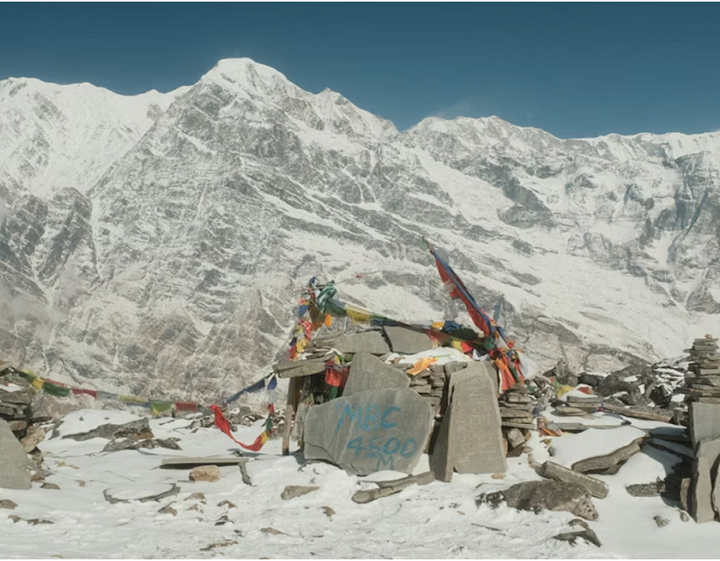One of the best ways to embark on an exciting and challenging adventure when planning your Himalayan Base Camp Trek is to go with a Sherpa-led expedition. Sherpas are the lifeblood of trekking in the Himalayas — there is no one better suited to the task than them, with unrivaled experience, in-depth knowledge of the region’s mountainous terrain, and knowledge like no one else about how to navigate through high-altitude conditions. This guidance proved invaluable in the treacherous paths and variable weather found on the trail to Everest Base Camp.
Sure, you can take a trek on your own, but when you go to all the bother of actually traveling to Nepal, a Sherpa-led trek gets you there safe (always a good thing) while being able to share rich cultural insights and local wisdom along the way. The Sherpa people originated in the Khumbu region of Nepal, where Mount Everest is located, and they are known for being strong and highly-skilled guides in the harsh mountain terrain. Besides first aid, acclimatization procedures, and emergency responses, they know everything about the places they work and keep the trekkers comfortable in high altitudes.
Even if you venture to Everest Base Camp, the trek to reach it is a physically taxing one, with constantly changing weather and challenging terrain, which is why it is vital to have an experienced Sherpa leading the way. Sherpas manage altitude sickness for trekkers by recommending pacing strategies for proper acclimatization. They are also knowledgeable about the route and can provide commentary on the beautiful nature, Buddhist monasteries, and cultural landmarks along the way.
An expedition led by a Sherpa adds immeasurable value to the trip, providing both safety and practical support as well as an authentic cultural experience. Sherpas are custodians of Sherpa traditions — they tell stories about their culture, share customs and knowledge of local flora and fauna — a unique, memorable experience for trekkers. We look after each other, and the bond between Sherpa and trekker, forged through trust and an understanding of shared purpose, makes a daunting trek so much more than just a physical challenge.
In summary, a Sherpa-led trek to the Everest Base Camp is more than just a physical accomplishment – it’s a chance to enjoy Himalayan culture, get local knowledge, and contribute more to making the trek as safe and enjoyable as it can be.
The Essential Role of Sherpas on Everest Voyages
They have contributed significantly to the successful completion of the Himalayas expeditions, especially for climbing to Everest Base Camps (EBC). Due to their intimate knowledge of the land and environment, and by their decades of mountaineering experience, they have become an inseparable part of land-based trekking in this high-altitude region. The Sherpa people are indigenous to the Khumbu region of Nepal, and their generations of cultural and environmental knowledge make them uniquely qualified to guide, support, and keep trekkers safe on their journey to Mount Everest.
Sherpas also enrich travelers’ experiences by connecting them to the area’s culture and history, something that guides tend to do differently. Sherpas make sure the trekkers are safe, sufficiently acclimatized, and understand the high-altitude environment and its dangers. As seasoned guides, porters, and guardians of the trek, Sherpas play an incomparable role in making an Everest expedition not just possible, but memorable.
Trekking with Sherpas is not just about hiring a guide — it’s about delving into a society that knows the door to not just the safety but the spirit behind the expedition to Everest. The Everest Base Camp trek is all about the Sherpas, and their assistance can determine whether your dream of standing at the base of the world’s tallest mountain comes true.
Role of Sherpas: Guides, Porters, and Guardians of Trek
The role of a Sherpa in any Everest Base Camp (EBC) expedition is multidimensional. Guides are trained to traverse the harsh landscape of the Himalayas, keeping trekkers on the right path, safe from hazards. Their familiarity with the mountain passes, weather patterns, and terrain ensures trekkers are well looked after and remain on course during the trek.
Not just guides, though many Sherpas work as porters, helping transport heavy loads of trekking equipment, food, and supplies. This is crucial as it allows trekkers to only carry the bare essentials, not weighing the excursions down with organized logistics. Sherpas help set a steady pace for trekkers, ensuring they acclimate adequately to the elevations.
One of the most vital roles that Sherpas take is being guardians of the trek. Sherpas serve as first responders with an acute awareness of the potential dangers, including altitude sickness. They’re trained in high-altitude first aid, can recognize early signs of health issues like fatigue or dizziness. They are also charged with making sure that trekkers are well-prepared for the Himalayan elements, which include advising what to eat, how to hydrate, and other well-being tips. They are also there to ensure that the journey is safe and successful, leaving trekkers free to enjoy the experience of reaching Everest Base Camp.
The History of Sherpas: The People behind Everest
Everest Base Camp trek cost For centuries, the Sherpas have been inextricably linked to Mount Everest and the surrounding Himalayan area. The Sherpa people have their origins on the Tibetan Plateau, migrating to the Khumbu region of Nepal approximately 500 years at one channel at this stage, and their adaptation to life in the high-altitude environment has been nothing short of magical. Their endurance, both mental and physical, and their almost intuitive knowledge of the rugged terrain have made them natural guides for an expedition to Everest Base Camp.
The Sherpas have had a long history with Everest expeditions starting in the early 20th century, during which the first major involvement in mountain climbing came in the 1920s. The Sherpa community’s extensive understanding of the terrain played a key role in helping foreign climbers and supporting expeditions. Over the years, they became a vital part of the successful first ascent of Mount Everest by Sir Edmund Hillary and Tenzing Norgay in the 1950s. All that has given rise to an international reputation for Sherpas as the experts in these types of high-altitude treks and some of the best climbers and guides in the world.
The Sherpa community remains integral to the climbing and trekking community today. Their constant contact with Everest and the Khumbu area is a reflection of both their skill and their important cultural relationship to the land, making them standard bearers in the journey to Everest Base Camp.
Sherpas are invaluable in every aspect of trekking.
Trekking with Sherpas: Life Beyond Physical Challenge to EBC Sherpas are not just guides — they are masters of the Himalayan terrain, adept at making sense of the mountain passes, and then ready to guarantee the safety and best interests of trekkers every step of the way. Their understanding of altitude sickness, weather conditions, and first aid treatments is invaluable for managing the risks that accompany high-altitude treks.
Yet the best thing about trekking with Sherpas is their great connection to local culture and the way of life in the Himalayas. Sherpas not only know the territory, but they also represent a link to the vibrant traditions and spiritual practices of the Khumbu. As trekkers ascend the trails leading to Everest Base Camp, Sherpas guide them through the Buddhist rituals and history of the Sherpa people, as well as the significance of sacred landmarks along the way, including Tengboche Monastery.
Sherpas also represent local hospitality, giving trekkers a glimpse of how the people in the region live. However, the most compelling aspect of this experience is that staying in Sherpa-led teahouses and breaking bread with Sherpas creates a sense of community and camaraderie that enhances the experience. Start your adventure with Sherpas who will give you a great cultural adventure and hiking experience: Sherpas are mountaineering guides who provide a complete adventure package that includes expert knowledge, cultural experience, and breathtaking views of the Himalayas.
What To Expect from a Sherpa-Led Expedition: Get Ready for the Trek
Trek To Base Camp Mount Everest Going on a Sherpa-led expedition is an adventure that allows you the opportunity to embrace the local culture. As any trekker knows, preparation for such an adventure requires knowledge of what lies ahead, so they can adequately plan for their Everest Base Camp experience.
Sherpa expeditions emphasize safety and acclimatization from the outset. You’ll be led through the difficult terrain at a pace that gives your body a chance to acclimatize to the high-elevation setting. Sherpas are trained to deal with altitude sickness and will keep an eye on your health through the trek.
Beyond keeping you safe, a Sherpa can also show you the Himalayan environment and provide insight into the local culture. During the trek, you’ll learn about Sherpa traditions, visit Buddhist monasteries, and experience the hospitality of the region. The trek to base camp is as much about every step as it is about gaining insight into the Sherpa way of life.
Sherpa-led expeditions are highly organized, and all logistics, permits , and accommodation are arranged. The itinerary will be well planned and include acclimatization days throughout the trek to minimize the risk of altitude-related issues. Sherpas will see that all the necessary equipment is included, your bags are carried by porters, and your only concern is the adventure itself.
With a Sherpa-led expedition, know that you will be in excellent hands and well prepared, alongside experience in the cultural & natural beauty of the Everest region.
Knowledge of the Land: The Role of Sherpas in the Everest Region
They are the perfect introduction to navigating the rugged terrain of the Everest Base Camp trek, where the route can be very remote and unpredictable. Himalaya guides hone your skills or trekking before you enter the mountains; they know every corner, and have been on tracks for months, even years (never mind your lifetime walking into it). It is usually a series of rough rocky paths winding steeply up and down are sore on the feet and can become treacherous quickly.
Everest Base Camp Trek Such familiarity with the terrain is crucial to ensuring trekkers don’t get lost, and that they’re always on the safest and most direct route to Base Camp. They know patterns in the weather, with the sleeping knowing when storms are coming and when conditions are safest to proceed. This understanding lowers the likelihood of accidents and lets trekkers concentrate on the immense beauty and astonishing vistas of the Khumbu region, especially the majestic peaks, glaciers, and untouched valleys.
Also, Sherpas assist trekkers in coping with the conditions of the terrain, such as the high altitude, which has a damaging effect on the human body. By managing speed, suggesting breaks, and helping trekkers navigate tricky areas, Sherpas help make sure that every leg of the journey is done safely. Their local knowledge makes them invaluable partners on the trek to Everest Base Camp, helping to minimize unnecessary risks while enhancing the experience.
Safety Through Altitude: How Sherpas Keep You Secure
The big reason why Sherpas are an essential part of any trek to the Everest Base Camp is that they are well-trained in walking through the mountain hurdles and the altitude to keep the trekkers safe. As trekkers climb high into the Himalayas, the danger of altitude sickness rises, a potentially life-threatening condition if not treated correctly. As people who live and work in high-altitude environments, Sherpas understand how to avoid and treat acute mountain sickness (AMS) symptoms.
Sherpas lead the group at a steady pace on the trek, which is important for good acclimatization. They know the adage of climb high, sleep low, where you help your body acclimatize to thinner air by increasing your elevation slowly but giving it a rest at lower elevations. These methods reduce the risk of AMS and allow trekkers to continue their journey without putting their health at risk. And Sherpas are trained to notice the early signs of altitude-related issues and can take action immediately, whether it be descending to a lower altitude or administering basic first aid.
In addition, Sherpas help to ensure the safety of trekkers by transporting top-quality first-aid kits and making sure they are ready for emergencies. They also help in ensuring communication with other trekkers and guides, so everyone is kept in the loop about any dangers or obstacles on the road. Sherpas are experts in trekking in the Himalayas and are fully knowledgeable of the necessary precautions and measures needed for the trekkers to remain healthy and safe throughout the entire experience, including how to deal with altitude sickness.
Sherpas: The Backbone of Every EBC Expedition
As guides, Sherpas do more than help you find your way; their support is the bedrock of an Everest Base Camp Treks. And while they must know how to traverse the terrain, manage altitude, and ensure safety, they help out beyond logistics. Sherpas are essential in ensuring that the journey is a comfortable and memorable one, as they help trekkers acclimatize to the unique challenges of being on the mountain.
Sherpas function as cultural ambassadors and provide a glimpse into the local customs, religion, and traditions. They impart their knowledge of Sherpa history, Buddhist practices, and the geography of the Khumbu region, adding fascinating stories and perspectives to the trek experience that trekkers might otherwise overlook. This connection to the Sherpa culture makes the trek much more than a physical trek — it is a spiritual and cultural trek as well.
In addition, Sherpas are frequently responsible for organizing the logistics of the trek, making sure that lodging and food are correctly arranged at various spots along the way. They also set up camp, carry gear, and help trekkers keep track of their supplies. The net result is a more seamless, enjoyable journey that enables trekkers to better appreciate the natural beauty that surrounds them as opposed to the potential amelioration of organising their trek. The Sherpa’s emotional support and positive encouragement throughout the trek also contribute to the overall experience, enabling trekkers to overcome difficult stages.
Sherpa Traditions: Cultural Encounters en Route
Experiencing the Sherpa way of life and culture is one of the features of trekking to Everest Base Camp with a Sherpa guide. Climbing through the Khumbu region, Sherpas tell stories of their deep connection to the land, its history, and people. As well as being trained mountain guides, these people have a deep understanding of the cultural and spiritual importance of the places along the route.
Of all the cultural experiences along this Everest trek, one of the most memorable is the incorporation of Buddhist spirituality into everyday life. Sherpas are sometimes devout Buddhists, and trekkers find sacred landmarks along the route, including mani stones, prayer wheels, and Buddhist monasteries. Sherpas often elaborate on the meaning of such religious symbols, providing perspective on how they inform life in the Himalayas. Tengboche Monastery, trekkers may even see local ceremonies or blessings that help give them a window into this region’s spiritual life.
Apart from the religious practices, Sherpas also expose trekkers to their way of living, culture, and the social bonds they share. This means trekkers get a glimpse into day-to-day life in carefully constructed Sherpa villages: yak caravans carrying goods, the non-complex yet ruggedism of the Sherpa lifestyle, et al. All these offer a colourful cultural setting to the trek and add substance to the trek to Everest Base Camp way beyond just conquering the physical challenge.
Final Thoughts: Signing Up for a Sherpa-Led EBC Expedition is the Best Way to Go
There is no better way to do the Mount Everest base camp Trek than with a Sherpa-led expedition. Beyond leading trekkers, Sherpas offer invaluable expertise that helps with safety, enhances the cultural experience, and makes for a smoother, more enriching journey overall. Customs, such as traversing through the local terrain and tackling high-altitude challenges, are second nature to them — no wonder they are such an invaluable partner for anyone pursuing the trek to Everest Base Camp.
Beyond their utilitarian function, Sherpas serve to foster a sense of community and friendship, providing hikers with a mixture of moral and emotional support during the trip. They are the unsung heroes who handle logistics, provide first aid, tell local stories, and above all, ensure that trekkers reach Base Camp and return safely.
Opting for a Sherpa-led expedition, trekkers gain an experience beyond a trek up to the base of the world’s highest mountain. They have a cultural exchange that allows them to learn more about the Sherpa people, their culture, and their resilience. Not just the trekking expert, the Sherpa guide is also integral to the narrative, transforming a trek to Everest Base Camp into a transformative rite of passage.
How much does a trip to Everest Base Camp cost?
How Much Does It Cost to Trek to Everest Base Camp (EBC)? For general guidance, its cost can vary greatly depending on several factors: the time of year you hike, the type of tour/trek you book, and whether you take a guided expedition or do it on your own. An average professional trek to EBC can range from $1,000 to USD 2,500 for a 14 to 16-day trek. This cost usually includes permits, guides, porters, accommodation, and meals along the way. Nevertheless, if you choose more luxurious services or upgrade your accommodation, the price will probably be higher.
Trekking independently, without a guide, can reduce the costs, but you will still need to budget for permits (such as the TIMS card and Sagarmatha National Park fee), flights to Lukla, accommodation, and food on the trek. Budget trekkers can keep costs down by staying in tea houses and dining locally. Many trekkers also pay for a porter to help carry their belongings, which increases the cost. For example, the price of a flight ticket to Lukla (the location where the trek starts) can significantly impact the overall cost of the trek, as a flight to Lukla is costly.
So all in all, your decisions for comfort, length, and services will weigh on the trek to Everest Base Camp price, although it is still one of the cheapest high-altitude treks for an iconic experience in the Himalayas.
How difficult is the EBC trek?
The Everest Base Camp (EBC) trek is moderately difficult. Though it isn’t as technical or rigorous as climbing to the top of Mount Everest, it does pose a host of challenges, not least of which are its high altitude, treacherous ground, and physical toll. The trek requires long days of walking over multiple days (6-8 hours daily), climbing through different altitudes (from the beginning point in Lukla at 2800 meters in altitude to the EBC at 5364 meters).
Altitude is one of the biggest challenges trekkers come up against. As you go up, the air gets thinner, making it more difficult to breathe, and your body may have to acclimatize to avoid altitude sickness. And proper acclimatization days are crucial, as the trek has a lot of rest days in Namche Bazaar and Dingboche to accommodate. The trek is also a challenge for many, combining trekking at high altitudes with the physical exertion needed to hike the steep inclines and rocky paths.
The weather has a mind of its own, too, particularly in the winter months, with temperatures dropping well below freezing. Wet and snowy weather can make the ground very slippery and treacherous. That said, with a good level of fitness, with slow walking, and appropriate conditioning to the altitude, the EBC trek is within reach of most.
How many days is the EBC trek?
A standard Everest Base Camp (EBC) trek takes 12 to 14 days, actual times depend on your pace and acclimatization requirements. Most treks start with a flight to Lukla, marking the beginning of the adventure. The first few days are a hike through the Khumbu region, including Namche Bazaar, Tengboche, and Dingboche, with some stops to acclimatize and reduce the risk of altitude sickness.
Everest Base Camp Others (if you want a more taking your time experience), may bring the trek out to 16 days to have more downtime and acclimate better to the altitude. On average, hiking to Everest Base Camp takes about 7 to 9 days, and the descent back to Lukla takes roughly the same amount of time.
The trek is typically divided into segments of 4 to 6 hours of trekking each day, with some longer days and others that are shorter to allow for better acclimatization. So, if we add all the trekking days, we get some 8-9 days of trekking, and the rest of the time is halting days or travel time for coming and going from the trekking route. The duration of the trek depends on fitness, acclimatization needs, and the trekking company you choose, ranging from 16 to 26 days.
How Much Do Sherpas Get Paid?
Sherpas are vital to the success of any Everest Base Camp trek, and their wages depend on experience, the trekking company, and the length of the trek. While the daily wage of a Sherpa guide is typically in the $25 to $50 USD range, it can vary widely depending on how many days the trek is, the difficulty of the route, and whether they’re guiding or just acting as a porters.
Sherpas employed as porters, who lug trekking equipment, food, and other supplies, usually make $15 to $30 USD a day. (NB: Sherpas get tipped by the trekkers at the end of the trip, and this can considerably increase their income level.s) Plus, some of the Sherpas’ mountain companies pay them a bonus for administrative work per successful expedition.
Although these salaries appear low in comparison to those within Western nations, it must be stated that the cost of living in the region is greatly reduced, and this is typically supplemented through further seasonal work or by the families’ farming during the off-season. The wages Sherpas make are vital to the local economy and to their families and communities in one of the most isolated regions of the world.
How many Sherpas died on Everest?
In recent years, several Sherpas have died on Everest expeditions, either leading trekkers to Base Camp or supporting climbers in their quest for the summit. The hazards of Mount Everest are many and demand the utmost caution, as you have unpredictable weather, treacherous conditions, altitude sickness, and even the most experienced climbers and guides are subject to the threats it presents.
Perhaps the most tragic event in Sherpa history occurred in 2014, when 16 Sherpas died in an avalanche on the Khumbu Icefall while facilitating expeditions up the peak. This event brought attention to the risks facing Sherpas on Everest, and their courage and sacrifice have since been recognized around the world.
While they do earn substantial wages for their work, it is essential to understand that Sherpas are essential to making Everest climbs safer, and their work in guiding, portering, and supporting trekkers and climbers is a foundation of any successful summit. The risks at high altitudes, especially in the death zone near the summit, are especially perilous, but he continues to bring his skills, fortitude, and bravery to aid others in their endeavors to achieve their own Everest dreams.
Although the number of Sherpa fatalities on Everest pales in comparison to that of trekkers and climbers, the sacrifice they make is a sobering reminder of the risks of high-altitude expeditions. To mark their courage, many trekkers and climbers gratefully donate money or memorials to Sherpas.






